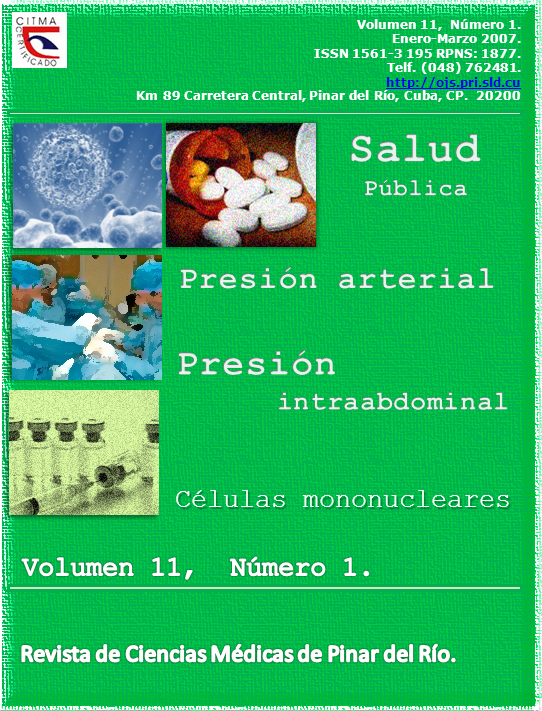Síndrome toracoabdominal. Presentación de un caso. Thoracoabdominal síndrome. A case report
Abstract
Se trata un caso de un recién nacido de la raza blanca, primogénito, nacido a las 39 semanas de gestación en parto eutócico, que ingresó en el Servicio de Cuidados Intensivos Neonatales por un defecto óseo y músculo aponeurótico, cubierto por piel desde el tercio medio distal del esternón que se extendía hasta el ombligo, siendo portador de una Ectopia Cordis Toracoabdominal, un Onfalocele minor y una persistencia del conducto arterioso sin repercusión hemodinámica, que evolucionó de forma favorable, colocándosele material sintético en el tórax (gorotex) como medio de protección. Fue egresado a los 16 días y reingresado a los 2 meses para la reparación del Onfalocele, falleciendo en un cuadro de fallo multiorgánico por sepsis. El fenotipo constatado en el propósitus se consideró compatible con el Síndrome Toracoabdominal, de patrón de herencia dominante ligada al X (MIM: 313850), reportado por Carmi et al en 1990, constituyendo el segundo caso esporádico reconocido en Pinar del Río (Cuba) en dos familias no relacionadas.
Palabras clave: CARDIOPATÍAS CONGÉNITAS, PERSISTENCIA DEL CONDUCTO ARTERIOSO, RECIÉN NACIDO.
ABSTRACT
A Caucasian male newborn, first born, delivered at 39 weeks of pregnancy in an eutocic labor was admitted at the Intensive Neonatal Care Unit, presenting an osseous defect and aponeurotic muscle covered by skin of the distal median third of the sternum extended to the navel. He was a carrier of a Thoracoabdominal Ectopia Cordis, a minor Omphalocele and a Patent Ductus Arteriosus without hemodynamic repercussion evolving favorably with the placement of a synthetic material in the thorax (Gorotex) as a protection. The patient was discharged from the hospital at 16 days old and readmitted at 2 months old to restore the Omphalocele, dying of multiple organ failure due to sepsis. The phenotype observed on the propositus was compatible with the Thoracoabdominal Syndrome, which has a dominant trait pattern linked to X _chromosome (MIM: 313850) reported by carmi et al. In 1990. This was the second sporadic case reported in Pinar del Río, Cuba, in two families which were not related.
Key words: CONGENITAL HEART DISEASE , DUCTUS ARTERIOSUS PATENT, INFANT NEWBORN
Downloads
How to Cite
Issue
Section
License
Authors who have publications with this journal agree to the following terms: Authors will retain their copyrights and grant the journal the right of first publication of their work, which will be publication of their work, which will be simultaneously subject to the Creative Commons Attribution License (CC-BY-NC 4.0) that allows third parties to share the work as long as its author and first publication in this journal are indicated.
Authors may adopt other non-exclusive license agreements for distribution of the published version of the work (e.g.: deposit it in an institutional telematic archive or publish it in a volume). Likewise, and according to the recommendations of the Medical Sciences Editorial (ECIMED), authors must declare in each article their contribution according to the CRediT taxonomy (contributor roles). This taxonomy includes 14 roles, which can be used to represent the tasks typically performed by contributors in scientific academic production. It should be consulted in monograph) whenever initial publication in this journal is indicated. Authors are allowed and encouraged to disseminate their work through the Internet (e.g., in institutional telematic archives or on their web page) before and during the submission process, which may produce interesting exchanges and increase citations of the published work. (See The effect of open access). https://casrai.org/credit/



